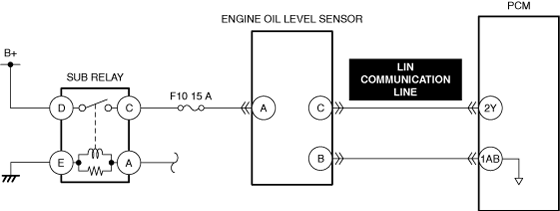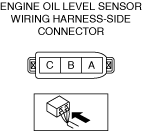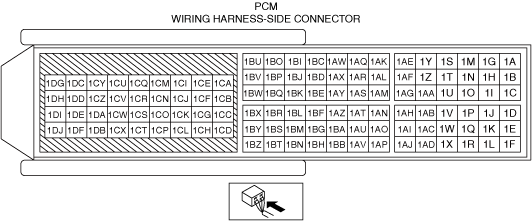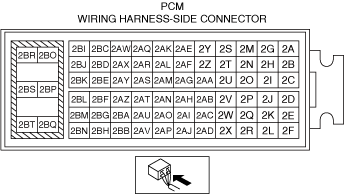DTC P250F:00 [PCM (SKYACTIV-G)]
DTC P250F:00 [PCM (SKYACTIV-G)]
SM2334562
id0102t4787400
-
Note
-
• To determine the malfunctioning part, proceed with the diagnostics from “Function Inspection Using M-MDS”.
Details On DTCs
|
Description |
Engine oil level signal: engine oil level low |
||
|---|---|---|---|
|
Detection condition
|
Determination conditions
|
• The engine oil level has decreased around or below MIN mark.
|
|
|
Preconditions
|
• Engine speed: 600—2,000 rpm *1
• Vehicle speed: 5 km/h {3 mph} or more *1
• Engine oil control: during low oil pressure
• Engine oil temperature: 20—90 °C {68—194 °F} *1
• G at front and back of vehicle: 0.2 G or less
• G at left and right sides of vehicle: 0.2 G or less
• The following DTCs are not detected:
*1: Standard can be verified by displaying PIDs using M-MDS
|
||
|
Drive cycle
|
• 1
|
||
|
Self test type
|
• CMDTC self test
|
||
|
Sensor used
|
• PCM
• Engine oil level sensor
• Engine oil temperature sensor
• Low-G (XY) sensor (built-into SAS control module)
|
||
|
Fail-safe function
|
• Not applicable
|
||
|
Vehicle status when DTCs are output
|
• Not applicable
|
||
|
Possible cause
|
• Improper engine oil level (low)
• Engine oil leakage
• Engine oil level sensor malfunction
• Erratic signal to PCM
• PCM malfunction
|
||
 |
|||
 |
 |
||
 |
|||
 |
|||
System Wiring Diagram
Function Explanation (DTC Detection Outline)
Repeatability Verification Procedure
PID Item/Simulation Item Used In Diagnosis
PID/DATA monitor item table
|
PIDs |
Reference |
|---|---|
|
ENG_OIL_LVL
|
Function Inspection Using M-MDS
|
Step |
Inspection |
Results |
Action |
|---|---|---|---|
|
1
|
PURPOSE: RECORD VEHICLE STATUS WHEN DTC WAS DETECTED TO UTILIZE WITH REPEATABILITY VERIFICATION
• Record the freeze frame data/snapshot data.
|
—
|
Go to the next step.
|
|
2
|
PURPOSE: VERIFY RELATED REPAIR INFORMATION OR SERVICE INFORMATION AVAILABILITY
• Verify related Service Bulletins, on-line repair information, or Service Information availability.
• Is any related Information available?
|
Yes
|
Perform repair or diagnosis according to the available information.
• If the vehicle is not repaired, go to the next step.
|
|
No
|
Go to the next step.
|
||
|
3
|
PURPOSE: INSPECT FOR OTHER RELATED DTCs
• Perform the DTC inspection for the PCM. (See DTC INSPECTION.)
• Are any other DTCs displayed?
|
Yes
|
Repair the malfunctioning location according to the applicable DTC troubleshooting.
|
|
No
|
Go to the next step.
|
||
|
4
|
PURPOSE: VERIFY IF THERE IS PID ITEM CAUSING DRASTIC CHANGES OF ACCELERATION FLUCTUATION BY INPUT SIGNAL TO PCM
• Access the following PIDs using the M-MDS: (See PID/DATA MONITOR INSPECTION.)
• Is the PID value within specification? (See ENGINE OIL LEVEL SENSOR INSPECTION [SKYACTIV-G (WITH CYLINDER DEACTIVATION (US))].) (See ENGINE OIL LEVEL SENSOR INSPECTION [SKYACTIV-G (WITHOUT CYLINDER DEACTIVATION (US))].)
|
Yes
|
Go to the next step.
|
|
No
|
Go to Troubleshooting Diagnostic Procedure to perform the procedure from Step 1.
|
||
|
5
|
PURPOSE: VERIFY CONNECTOR CONNECTIONS
• Access the following PIDs using the M-MDS: (See PID/DATA MONITOR INSPECTION.)
• When the following parts are shaken, does the PID value include a PID item which has changed?
|
Yes
|
Repair or replace the applicable connector parts.
Go to Troubleshooting Diagnostic Procedure to perform the repair completion verification.
|
|
No
|
Go to Troubleshooting Diagnostic Procedure to perform the procedure from Step 1.
|
Troubleshooting Diagnostic Procedure
-
― Perform inspection of engine oil leakage.
-
― Perform inspection of engine oil level.
-
― Inspect for clogging of the oil passage to the engine oil level sensor detection area.
-
― Perform an inspection of LIN communication line.
-
― Verify that the primary malfunction is resolved and there are no other malfunctions.
|
Step |
Inspection |
Results |
Action |
|---|---|---|---|
|
1
|
PURPOSE: INSPECT ENGINE OIL LEAKAGE
• Start the engine.
• Verify that there is no engine oil leakage in the hydraulic circuit.
• Is there any leakage?
|
Yes
|
Repair or replace the malfunctioning location, then add genuine motor oil.
Perform the “ENGINE OIL DATA RESET” and perform the repair completion verification.
|
|
No
|
Replace the engine oil level sensor, then go to the next step.
|
||
|
2
|
PURPOSE: INSPECT ENGINE OIL LEVEL
• Inspect the engine oil level. (See ENGINE OIL LEVEL INSPECTION [SKYACTIV-G (WITH CYLINDER DEACTIVATION (US))].) (See ENGINE OIL LEVEL INSPECTION [SKYACTIV-G (WITHOUT CYLINDER DEACTIVATION (US))].)
• Is the engine oil level sufficient?
|
Yes
|
Go to the next step.
|
|
No
|
Add genuine motor oil.
Perform the “ENGINE OIL DATA RESET” and perform the repair completion verification.
|
||
|
3
|
PURPOSE: INSPECT FOR CLOGGING OF THE OIL PASSAGE TO THE ENGINE OIL LEVEL SENSOR DETECTION AREA
• Remove the engine oil level sensor. (See ENGINE OIL LEVEL SENSOR REMOVAL/INSTALLATION [SKYACTIV-G (WITH CYLINDER DEACTIVATION (US))].) (See ENGINE OIL LEVEL SENSOR REMOVAL/INSTALLATION [SKYACTIV-G (WITHOUT CYLINDER DEACTIVATION (US))].)
• Visually inspect the oil passage to the engine oil level sensor.
• Is there any restriction detected?
|
Yes
|
Clean the oil passage and perform the repair completion verification.
|
|
No
|
Go to the next step.
|
||
|
4
|
PURPOSE: INSPECT ENGINE OIL LEVEL SENSOR CONNECTOR FOR MALFUNCTION
• Inspect the applicable connector and terminal. (See CONNECTOR INSPECTION.)
• Are the connector and terminal normal?
|
Yes
|
Go to the next step.
|
|
No
|
Repair or replace the malfunctioning location and perform the repair completion verification.
|
||
|
5
|
PURPOSE: INSPECT LIN COMMUNICATION LINE FOR OPEN CIRCUIT
• Inspect the applicable circuit for open circuit. (See CIRCUIT INSPECTION.)
• Is the circuit normal?
|
Yes
|
Replace the engine oil level sensor and perform the repair completion verification.
|
|
No
|
Repair or replace the malfunctioning location and perform the repair completion verification.
|
||
|
Repair completion verification 1
|
PURPOSE: VERIFY THAT VEHICLE IS REPAIRED
• Install/connect the part removed/disconnected during the troubleshooting procedure.
• Clear the DTC recorded in the memory. (See CLEARING DTC.)
• Replicate the vehicle conditions at the time the DTC was detected using the following procedure.
• Perform the DTC inspection for the PCM. (See DTC INSPECTION.)
• Is the same Pending DTC present?
|
Yes
|
Refer to the controller area network (CAN) malfunction diagnosis flow to inspect for a CAN communication error.
If the CAN communication is normal, perform the diagnosis from Step 1.
• If the malfunction recurs, replace the PCM, then go to the next step. (See PCM REMOVAL/INSTALLATION [SKYACTIV-G (WITH CYLINDER DEACTIVATION (US))].) (See PCM REMOVAL/INSTALLATION [SKYACTIV-G (WITHOUT CYLINDER DEACTIVATION (US))].)
|
|
No
|
Go to the next step.
|
||
|
Repair completion verification 2
|
PURPOSE: VERIFY IF OTHER DTCs DISPLAYED
• Perform the DTC inspection. (See DTC INSPECTION.)
• Are any other DTCs displayed?
|
Yes
|
Repair the malfunctioning location according to the applicable DTC troubleshooting.
|
|
No
|
DTC troubleshooting completed.
|